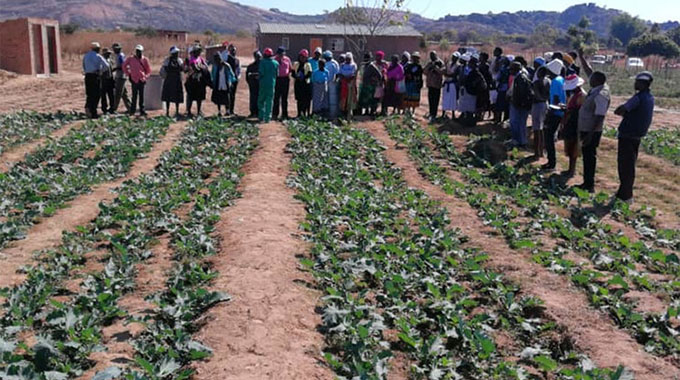HIT launches new irrigation system

Sallomy Matare Herald Reporter
Harare Institute of Technology (HIT) has launched a new spot irrigation system called Scientific Conservation Irrigation Technology (SCIT) that allows farmers to maximise production and save water.
Power Conservation Agri-Clinic Trust (PCAT) engineer and HIT lead researcher Joseph Ngirande (34) developed SCIT after eight years of research.
The new irrigation system was launched in Domboshava recently, in the presence of Ministry of Lands Agriculture, Water, Climate and Rural Resettlement officials and other investors in the agriculture sector.
SCIT is a hybrid system of integrating water conservation and nutrients recycling from organic matter using zero tillage or conservation agriculture method.
Power Conservation Agri-Clinic Trust (PCAT) in collaboration with HIT piloted and implemented this technology in Chirumanzu and other parts of the country as part of research to develop smart technology for climate change adaptation.
Yields of 18 tonnes of maize per hectare were achieved on experimental plots.
Ngirande, the brains behind the innovation, says SCIT is a spot irrigation system that efficiently addresses the issue of water scarcity.
“SCIT is one of the climate change adaptation technologies in Zimbabwe, developed as a technical solution to drought and water scarcity in Zimbabwe and beyond,” he says.
SCIT is a system that uses plant moisture conservation potholes filled with manure to conserve moisture for a long time.
It also provides health feeding to the soil.
The manure used to fill the potholes are known as stick compost and vermi composting which are distributed at a ratio of 2:1 respectively.
The compost has some materials which absorbs water and when water dries up, the manure can then release the stored moisture.
The worms used to make vermi compost excrete and provide more moisture.
With this system, it is easy to keep track of the amount of water that is used per hectare because 1 litre is used per pothole once a week.
“The technology has proved to be a more efficient method as it promotes efficient use of water in cropping systems because precise quantities of water are used for effective crop production,” says Ringson Chitsiko, permanent secretary in the Ministry Of Lands Agriculture, Water, Climate and Rural Resettlement.
“It is against this background that we are convinced that this is a ground-breaking technology that will change the face of crop production in Zimbabwe, particularly in the smallholder sector.
“We are particularly excited by the fact that it is easily implementable in small scale farming communities which makes the bulk of our population.”
AgriSeeds sales and marketing director, Ivan Craig also hailed the technology saying it could help provide nutrients to replenish the soil.
“Most of the soils in Zimbabwe are acidic and this technology can help to balance the PH levels in the soil. It has all required nutrients for crops to grow,” he says.
“This technology has a lot of advantages and I encourage farmers to adopt it.
“It is very useful and yield is guaranteed because yield is determined by plant population per unit area. This technology achieves the required plant population which gives the yield.
The system is also very economic because the main inputs which are manure can easily be sourced locally at little cost. The most important things that are needed are water, anthill soil, humus and cattle dung manure — for stick and vermi composting.
“From our experiments in Chirumanzu we have seen that we can harvest as much as 18 tonnes of maize per hectare,” says Ngirande.
The system can also enhance the country’s export competitiveness in the production of organic crops.
“This will see Zimbabwe exporting more organic produce which are in high demand in European markets,” says Ngirande. “Organic farming has so much value on the international market.”
He says the commercialisation of this irrigation system could lead to development of other technologies that can make work easier and faster on a large scale.
“Under the commercialisation of the technology we have come up with the idea of a potholing tractor, spot irrigation nap sack and spot irrigation centre pivot,” he says.
“The implementation of the technology will also lead to the development of a water harvesting bay which will sustain rain water and runoff water which can be reused to water crops.”
The innovator says he needs about $3,5 million to commercialise this new technology.
This technology can be utilised for all other crops except tobacco and potatoes.
Plaxedes Musademba of HIT’s department of Environmental Management Renewable Energy and Climate Change says this innovation is timely and will help local farmers to cope with increased frequency of droughts and water scarcity.
“SCIT uses water efficiently and can help farmers in drought prone areas to manage their water effectively.
“Water is scarce and any technology that helps to save water is welcome.”
Renewed interest and giving prime attention to irrigation by the Government has largely stemmed from climate change related risk and their impact on the livelihoods of the poor.
Irrigation farming is vital, especially in dry regions where there are more failed crops.
The utilisation of water for irrigation by the agriculture sector is still below capacity and needs to be urgently revitalised. The total developed irrigated area in 2000 was estimated at 200 000 hectares, accounting for 80 percent of national water demand.
Currently, 206 000 hectares of the developed 263 000ha is functional according to a 2017 Ministry of Lands Agriculture, Water, Climate and Rural Resettlement report.
Agricultural experts say new irrigation technologies must be adopted by smallholder farmers to spur agricultural production in the country.







Comments